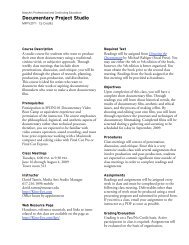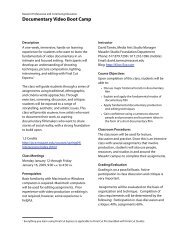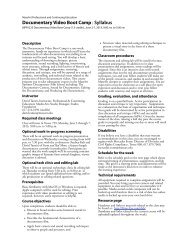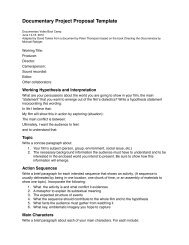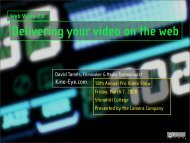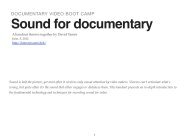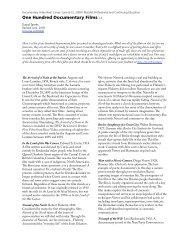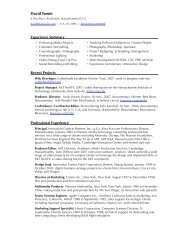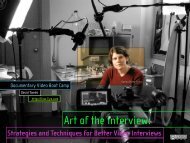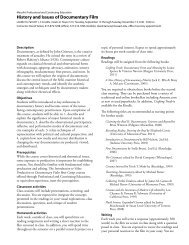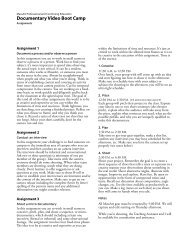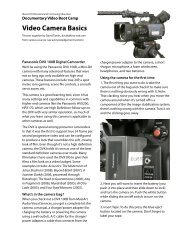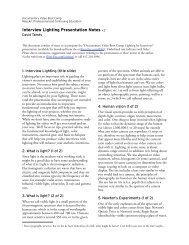Documentary Video Boot Camp : Syllabus
Documentary Video Boot Camp : Syllabus
Documentary Video Boot Camp : Syllabus
Create successful ePaper yourself
Turn your PDF publications into a flip-book with our unique Google optimized e-Paper software.
MassArt Professional and Continuing Education<br />
<strong>Documentary</strong> <strong>Video</strong> <strong>Boot</strong> <strong>Camp</strong> : <strong>Syllabus</strong><br />
MPFV225 <strong>Documentary</strong> <strong>Video</strong> <strong>Boot</strong> <strong>Camp</strong> (1.5 credits) , January 7-11, 2013, 9:00 A.M. to 4:30 P.M.<br />
Description<br />
e <strong>Documentary</strong> <strong>Video</strong> <strong>Boot</strong> <strong>Camp</strong> is a one-week,<br />
immersive, hands-on experience in which you’ll<br />
learn the fundamentals of video documentary<br />
storytelling in an intimate and focused setting. You<br />
will develop a basic understanding of shooting<br />
techniques, picture composition, sound recording,<br />
lighting, interviewing, and editing. We’ll also cover<br />
a brief survey of history and ethical issues. e core<br />
of the class is a series of hands-on exercises exploring<br />
traditional, personal, and cinéma vérité approaches.<br />
rough the exercises, screening, discussion, and<br />
critique, you will be exposed to a range of aesthetic,<br />
storytelling, and technical issues related to the<br />
production of documentary videos.<br />
Instructor<br />
David Tamés, <strong>Documentary</strong> Filmmaker and<br />
Media Arts Studio Manager, Studio Foundation<br />
Department, MassArt<br />
617.216.1096 (mobile)<br />
david.tames@massart.edu<br />
Class meetings<br />
Class will meet in South 305, Monday, January 7<br />
through 11, 2012, 9:00 a.m. to 4:30 p.m. ere will<br />
be an optional technology clinic & editing lab on<br />
ursday evening from 5:00 p.m. to 8:00 p.m. in<br />
which students can spend additional time editing<br />
and/or ask production or editing related questions.<br />
Prerequisites<br />
Basic familiarity with MacOS or Windows is<br />
required. Apple computers will be used for editing.<br />
Prior experience with video production or editing is<br />
not required, however, some experience is helpful.<br />
Course objectives<br />
Upon completion, you should be able to:<br />
• Discuss in broad strokes some historical trends<br />
in documentary lm,<br />
• Describe the fundamental characteristics of a<br />
documentary lm,<br />
• Apply basic camera and sound recording<br />
techniques to observe people and processes, and<br />
• Structure video materials using editing<br />
techniques to present a visual story in the form<br />
of a short documentary lm.<br />
Classroom procedures<br />
e classroom and editing lab will be used for<br />
lecture, discussion and practice. In addition to in-<br />
class presentations and exercises, some readings will<br />
be assigned. Since this is an intensive class with<br />
several exercises that involve real documentary<br />
production techniques, you and your fellow<br />
students will make use of the people, resources, and<br />
studios in and around the MassArt campus to<br />
complete their assignments. You are expected to<br />
treat the classroom as a safe place for open<br />
expression and discussion and to treat your fellow<br />
students with courtesy and respect at all times.<br />
Grading, evaluation, and attendance<br />
Grading is on a pass/fail basis. Active participation<br />
in discussion and critique is very important.<br />
Assignments are evaluated on the basis of<br />
organization and technique. Your grade will be<br />
determined by active participation in class<br />
discussion and critique (40%) and successful<br />
completion of all assignments (60%). Given the<br />
intense nature of the class, missing a half day puts<br />
the course grade in jeopardy and missing one day or<br />
more will resul in not passing the class.<br />
Disabilities<br />
If you believe you have a disability that may warrant<br />
accommodations in this class, you are encouraged to<br />
register with Mercedes Evans, Director of Diversity<br />
and Civil Rights Compliance, Tower 808,<br />
617.879.7060, mercedes.evans@massart.edu<br />
Schedule for the week<br />
Refer to the schedule grid on the next page which<br />
shows estimated timing of presentations,<br />
assignments, and lab time. is grid is a starting<br />
point and adjustments may be made at the<br />
instructor’s discretion in order to enhance the<br />
learning experience.<br />
Technical requirements<br />
All equipment required to complete assignments<br />
will be provided. You may bring your own camera<br />
and related equipment to class and we’ll try to<br />
accommodate it if possible. If you’d like to take your<br />
project work home, a portable hard-drive is<br />
recommended. Media stored on lab computers will<br />
not be backed up and therefore there is a risk of<br />
data loss unless media is backed up onto a second<br />
hard drive.<br />
Resource page<br />
Handouts and links to materials related to the class<br />
may be found at http://Kino-Eye.com/dvb/<br />
(handouts and links related to the current course<br />
will be uploaded/updated throughout the week).
MassArt Professional and Continuing Education<br />
<strong>Documentary</strong> <strong>Video</strong> <strong>Boot</strong> <strong>Camp</strong> : Schedule<br />
MPFV225 <strong>Documentary</strong> <strong>Video</strong> <strong>Boot</strong> <strong>Camp</strong> (1.5 credits) , January 7-11, 2013, 9:00 A.M. to 4:30 P.M.<br />
Monday Tuesday Wednesday Thursday Friday<br />
9:00<br />
4: Rough Cut (9 - 11:45 a.m.)<br />
The <strong>Documentary</strong> Landscape<br />
Screen/Critique of Assignment 3<br />
Documenting Process<br />
Introductions<br />
What is documentary?<br />
10:00<br />
Editing the <strong>Documentary</strong><br />
Directing the <strong>Documentary</strong><br />
Exercise 2: Process<br />
Case Study: Abattoir Rising<br />
Exercise 4: Mini-<strong>Documentary</strong><br />
w/ Co-Directors Audrey Kali & David<br />
Select/Export Assignment 2<br />
1: Conceive (11:30- 12:30 p.m.)<br />
Tamés and Editor Carla Pataky<br />
Quick Check-In (11:45 a.m.)<br />
Lunch (12 - 12:30 p.m.) (Working Lunch)<br />
Lunch (12 - 1:00 p.m.) Lunch (12 - 12:30 p.m.)<br />
11:00<br />
Observing People &<br />
Environments<br />
12:00<br />
Lunch (12 - 12:30 p.m.)<br />
5: Fine Cut (12:45 p.m. - 3:00 p.m.)<br />
Exercise 5: Editing the Mini-<strong>Documentary</strong><br />
2: Pitch (12:30- 1:30 p.m.)<br />
Screen/Critique of Assignment 2<br />
Camera Fundamentals<br />
1:00<br />
1: Capture & Plan (1:30-3:30 p.m.)<br />
3: Plan (1:30 - 2:30 p.m.)<br />
Interviewing/Lighting/Sound<br />
Exercise 1: Observation<br />
2:00<br />
4: Shoot (2:30 - 4:30 p.m.)<br />
Exercise 3: Interview<br />
Intro to Editing with Adobe Premiere Pro<br />
3:00<br />
5: Screen/Critique Projects<br />
(3:00 p.m. - 4:30 p.m.)<br />
2: Screen/Critique of Selected Rushes<br />
(3:30-4:30 p.m.)<br />
Select/Export Assignment 1<br />
Select/Export Assignment 3<br />
Screening & Critique of Assignment 1<br />
4:00<br />
Review / Q&A<br />
Review / Q&A<br />
Class ends @ 4:30 p.m. Class ends @ 4:30 p.m.<br />
3: Editing Lab<br />
(5:00 p.m. to 8:00 p.m.)<br />
Class ends @ 4:30 p.m.<br />
Class ends @ 4:30 p.m.<br />
5:00<br />
MassArt gear must be returned<br />
to the classroom no<br />
later than 5 p.m.
MassArt Professional and Continuing Education<br />
<strong>Documentary</strong> <strong>Video</strong> <strong>Boot</strong> <strong>Camp</strong> : Exercises<br />
MPFV225 <strong>Documentary</strong> <strong>Video</strong> <strong>Boot</strong> <strong>Camp</strong> (1.5 credits) , January 7-11, 2013, 9:00 A.M. to 4:30 P.M.<br />
During this class you will always working on a<br />
highly constrained xed-time basis, so work quickly<br />
and diligently and always be back in the classroom<br />
at the agreed upon time. e goal of the exercises<br />
this week is to be as creative and expressive as you<br />
can within the limitations of time and resources.<br />
ink lightness, you are sketching, not creating a<br />
nished project. Reecting on your process and<br />
impulses is as important as shooting, so allow time<br />
for that as you are working.<br />
Exercise 1: Observation<br />
Find a willing human subject, or if you prefer,<br />
moving objects in a particular setting (e.g. cars<br />
navigating an intersection, people in Evans Park, the<br />
Green Line trolley, etc.), to shoot for twenty minutes.<br />
Using natural light, gather as many different and<br />
expressive shots from a variety of shot types and<br />
camera angles (shoot a variety of shots varying not<br />
only the x,y but also the z dimension) you can of<br />
your subject. Don’t be concerned with recording<br />
audio or dialog, don’t interview, only observe. Select<br />
your shots carefully, don’t let the camera run and<br />
run. Reect on what you’ve shot after each shot and<br />
what the next shot should or could be. Produce a<br />
mixture of moving and stable tripod shots. Look<br />
especially at the lines, shapes, textures, movements,<br />
gestures, patterns, you can discover and create while<br />
observing with your camera. Make sure you’re back<br />
in the classroom at the agreed upon time. When<br />
you return to the classroom, Log and transfer your<br />
footage and look it over. Choose your ten best shots<br />
and cut into a sequence at least one minute, but no<br />
longer than two minutes, for screening in class. Do<br />
not include audio in the sequence you show in class.<br />
Exercise 2: Document a process<br />
In this exercise you are to work in small teams to<br />
observe a process or a person. Work fast to nd your<br />
subject, it’s more important to spend time<br />
observing, the actual topic is not critical. It can be a<br />
student, someone who works at MassArt, or<br />
someone you meet on the street in the area. Always<br />
be straightforward when people ask what you’re<br />
doing and why you’re doing it. ink in terms of<br />
establishing context and covering an activity from<br />
more than one camera position. Cut for temporal<br />
compression in the camera. Reect on what you<br />
choose to frame, and why you think you chose it.<br />
Record a series of shots (not too short, but not too<br />
long). Select your shots carefully, don’t let the<br />
camera run and run. Spend about 30 minutes<br />
shooting this exercise. Make sure you’re back in the<br />
classroom at the agreed upon time. When you<br />
return to the classroom, Log and transfer your<br />
footage and look it over. Choose your ten best shots<br />
and cut into a rough sequence about two minutes<br />
long, for screening in class. Include the ambient<br />
sound, but don’t worry too much about making<br />
perfect edits, you are making a very rough assembly.<br />
Exercise 3: Interviewing a subject<br />
In this exercise your challenge is to nd someone on<br />
campus or the immediate area who you can<br />
informally pre-interview and then conduct an on<br />
camera interview. e interview should be informal<br />
and conversational. Ask three or four questions (at<br />
least one from each member of the group). Take<br />
turns with the camera, everyone should do some<br />
shooting. When other team members are shooting,<br />
watch what they are doing closely. Don’t hesitate to<br />
offer suggestions or ask questions as you work.<br />
Make sure to shoot B-roll in order to establish your<br />
interviewee and/or the context for the interview.<br />
Make sure to get an on-camera release including the<br />
complete (letter by letter) spelling of the person’s<br />
name and any additional information you might<br />
consider relevant. By the way, in the real world, you<br />
should always get a written release.<br />
Exercise 4: Shoot a micro-documentary<br />
In this exercise you are to work in small teams to<br />
conceive, pitch, plan, and shoot a sequence, or<br />
micro-documentary, which should including at least<br />
one interview (formal or informal) and some<br />
observational footage. e exercise involves four<br />
xed-time phases. e idea is to be as creative and<br />
expressive as you can within the limitations of time<br />
and resources. It’s just as critical to work within the<br />
allotted time frames as it is to be creative in the<br />
execution of this exercise. Time is of the essence.<br />
STEP 1. CONCEIVE<br />
11:30 A.M. to 12:30 P.M.<br />
Over lunch, your group with will come up with an<br />
idea and start guring out how to shoot it in the<br />
afternoon. Make sure to schedule time with your<br />
subject or subjects for shooting in the afternoon,<br />
you will be on an ultra tight schedule.<br />
STEP 2. PITCH<br />
12:30 P.M. to 1:30 P.M. (10 MINUTES PER GROUP)<br />
Each group will pitch their project to the class.<br />
Express your idea in one or two short sentences (the<br />
elevator pitch), explain what the audience will take<br />
away from the piece, explain what resources you<br />
need, what are the possible pitfalls, and why you are<br />
uniquely qualied to make this documentary.
STEP 3. PLAN<br />
1:30 P.M. to 2:30 P.M.<br />
Take time to get your gear together, make a shot<br />
list, conrm any interviews you may have<br />
scheduled, make sure you have the camera set up<br />
properly, start with a freshly formatted SD (or P2)<br />
card, fully charged batteries, etc. Don’t jump ahead<br />
into production until you’ve made sure everything is<br />
working properly.<br />
STEP 4. SHOOT<br />
2:30 P.M. to 4:30 P.M.<br />
Shoot your micro-documentary. Remember the goal<br />
is to create a sequence of shots that tells a visual<br />
story and reects a creative expression of your<br />
observations of something happening in the real<br />
world. Shoot alternative angles, illustrate with<br />
images. Improvise and explore. Have fun. Be open<br />
to opportunities in the form of unexpected twists<br />
and turns. Recall our discussion about composition,<br />
angle changes, etc. Use the time available as<br />
productively as you can. Make a log as you shoot.<br />
Shoot for the edit and keep good notes. If your<br />
subject changes their mind and is not available at<br />
the last minute, you still need to make a lm. All<br />
MassArt gear must be returned to the classroom no<br />
later than 5:00 P.M. We will capture and edit<br />
starting on ursday afternoon. Technical notes:<br />
Shoot 1080/30P. If you are using your own camera,<br />
make sure to use a similar setting (especially in<br />
terms of 30P). If you are using multiple cameras,<br />
make sure they are all shooting the same format.<br />
Exercise 5: Edit the micro-documentary<br />
In this exercise you will work with your team to edit<br />
the footage shot for exercise 4. e basic steps<br />
include reading over the logs or notes made as you<br />
capture the footage. If you shot with multiple<br />
cameras, capture the footage from each camera on a<br />
separate workstation and I will show you how to<br />
merge your footage later. At the the end of the<br />
capture (and merge if you have multiple cameras)<br />
phase you will each end up with an identical copy<br />
of your project media on your editing workstation.<br />
Presentations on editing technique will be very<br />
brief, however, if you get stuck or want to know<br />
how to do something specic, ask the instructor or<br />
the teaching assistant. is part of the course is<br />
designed to provide a abbreviated introduction to<br />
editing along with “just in time learning” of the<br />
Adobe Premiere Pro features you need to complete<br />
this exercise.<br />
STEP 1. CAPTURE & PLAN<br />
ursday, 1:30 P.M. to 3:30 P.M.<br />
Groups will capture their footage and review it.<br />
While watching the footage, think about how you<br />
might organize what you have. You might cluster<br />
footage in terms of themes. e goal is to<br />
understand what you have to work with.<br />
STEP 2. SCREENING & CRITIQUE OF RUSHES<br />
ursday, 3:30 P.M. to 4:30 P.M.<br />
Each group will share with the class highlights of<br />
their best footage they have to edit with and the<br />
team that shot the footage will discuss their<br />
shooting experience in collaboration with the team<br />
that is now editing their footage. ink of this as<br />
the funders of your documentary visiting you in the<br />
editing room. ey want to see what you’ve been up<br />
to.<br />
STEP 3. EDITING LAB (OPTIONAL)<br />
ursday, 5:00 P.M. to 8:00 P.M.<br />
Get a head start on your editing, or get extra help<br />
with editing with Adobe Premiere Pro. You may also<br />
ask other production related questions. Highly<br />
recommended.<br />
STEP 4. ROUGH CUT<br />
Friday, 9:00 A.M. to 11:45 P.M.<br />
Each student will cut together a rough cut of the<br />
piece their team is editing piece. Collaborate with<br />
your team members. e technical goal for this<br />
phase is to develop familiarity with basic editing<br />
activities. Setting in and out points. Placing clips in<br />
the timeline. Trimming clips. Separating video from<br />
audio. Cutting clips with the razor blade.<br />
Understanding the difference between Insert and<br />
Overwrite edits. <strong>Video</strong> and audio tracks. Panning<br />
audio.<br />
STEP 5. FINE CUT<br />
Friday, 12:45 P.M. to 3:14 P.M.<br />
Team members will review each others rough cuts<br />
and discuss how to merge their ideas into a single<br />
ne cut. You can share project les, and drag and<br />
drop edited clusters of clips from one sequence to<br />
another in Adobe Premiere Pro. If you have not<br />
gured this out, let the teaching assistant or I know<br />
and we’ll will show you one on one. Don’t forget to<br />
allow at least 20 minutes to export your edit master<br />
to the external hard drive for screening on the<br />
instructor’s workstation. Screening and critique has<br />
to start at 3:15 P.M. sharp!<br />
STEP 6. SCREENING & CRITIQUE OF PROJECTS<br />
Friday, 3:15 P.M. to 4:30 P.M.<br />
Each team will screen their project followed by a<br />
critique. Time to celebrate your accomplishments.



